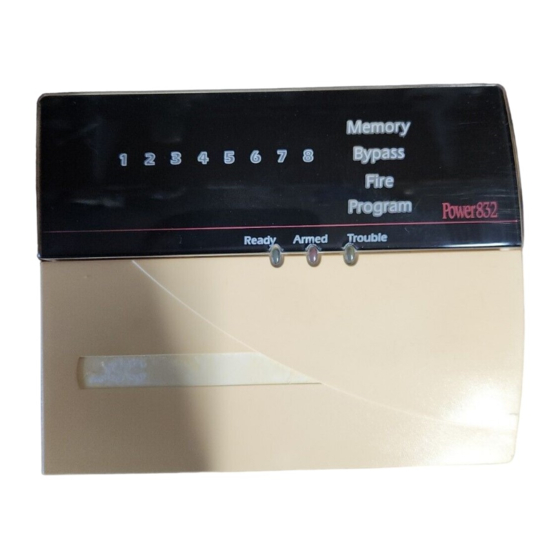
Table of Contents
Advertisement
1.1
Specifications
Control Panel Specifications
Flexible Zone Configuration:
• 8 Fully Programmable Zones
• 38 Access Codes: 32 User, 1 System Master, 2 Partition Master, 2 Duress and 1 maintenance
• Expandable to 32 Zones
• Keypads with zone inputs available (PC/KP5508Z, PC/KP5516Z, PC/KP5532Z, LCD/KPL5500Z)
• Hardwired expansion available using the PC5108 Eight Zone Expansion module, the PC5700 Fire
module, or the PC5720 Fire and DVACS module.
• Wireless expansion available using the PC5132 Wireless Zone Expansion module (up to 32 wireless
zones, 900MHz, True Spread Spectrum Technology, Fully Supervised)
• Normally Closed, Single EOL, or Double EOL zone supervision
• 2-Wire Smoke Input (via PGM2 input)
• 27 Zone Types, 8 Programmable Zone Options
• 2 Partitions
Audible Alarm Output:
• Supervised Bell Output (current limited at 3 amps), 12 V
• Steady or Pulsed Output
EEPROM Memory:
• Will not lose programming or system status on complete AC and Battery failure
Programmable Outputs:
• Up to 14 Programmable Voltage Outputs, 23 programmable options
• One High Current (300 mA) PGM output with 2 wire smoke detector capability on main panel
• Maximum Loop Current is 1.5 mA when the 2-wire smoke detector configuration is used
• One Low Current (50 mA) PGM output on main panel
• Eight Additional Low Current (50 mA) PGM outputs available using the PC5208 module
• Four High Current (1 Amp) PGM outputs Available Using the PC5204 module
• 1 PC5204 Output Fully Supervised for Siren Output
Powerful 1.5 Amp Regulated Power Supply:
• 500 mA Auxiliary Supply, 12 V
• Positive Temperature Coefficient (PTC) components replace fuses
• Supervision for loss of AC Power, Low Battery
• Internal Clock Locked to AC Power Frequency
Power Requirements:
• Transformer = 16.5 VAC, 40VA
• Battery = 12 volt 4 Ah minimum rechargeable sealed lead acid
Remote Keypad Specifications:
• 8 Different Keypads Available:
- PC5508 (Z )/KP5508 (Z) 8 Zone LED Keypad
- PC5516 (Z )/KP5516(Z) 16 Zone LED Keypad
• Each Keypad has 5 Fully Programmable Function Keys
• Four Wire (Quad) Connection to Keybus
Digital Communicator Specifications:
• Supports all Major Formats including SIA and Contact ID • Event Initiated Personal Paging
• 3 Programmable Phone Numbers
• Supports LINKS1000 Cellular Communication
• DPDT Line Seizure
• Split Reporting of Selected Transmissions to Each Telephone Number
System Supervision Features
The PC5010 continuously monitors a number of possible trouble conditions including:
• AC Power Failure
• Telephone Line Trouble
• Loss of Internal Clock
• Failure to Communicate
System Introduction
S
E
C
T
DC
• Trouble by Zone
• Low Battery Condition
• AUX Power Supply Fault
• Module Fault (Supervisory or Tamper)
I
O
N
1
DC
- PC5532 (Z )/KP5532 (Z) 32 Zone LED Keypad
- LCD5500 (Z)/ KPL5500 (Z) Alphanumeric Keypad
• Connect up to 8 Keypads
• Built in Piezoelectric Buzzer
• 2 Account numbers
• DTMF and Pulse Dialing
• Anti-jam Feature
• Fire Trouble
• Bell Output Trouble
• Tamper by Zone
1
Advertisement
Table of Contents















Need help?
Do you have a question about the PC5508 and is the answer not in the manual?
Questions and answers
Door replaced so trembles tampered whilst fixing to bew doors. Alarm system not monitored anymore, is now stand alone. Alarm will niw not set, ready light not illuminated. Can tamper be reset from keypad?
No, the tamper cannot be reset from the keypad on the DSC PC5508 alarm system. All tamper conditions must be physically restored before the trouble condition will clear.
This answer is automatically generated